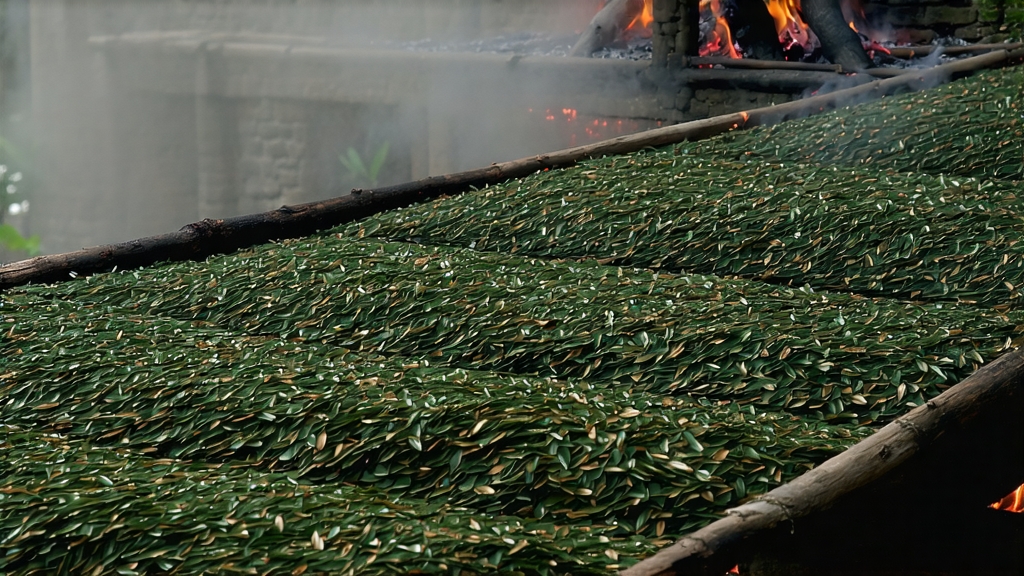
When European tea caravans first reached the bustling ports of Amsterdam and London in the early 1600s, the chests labeled “Bohea” carried an unfamiliar dark leaf that released a haunting scent of pine and smoldering resin. That leaf was Lapsang Souchong, the earliest black tea ever created and the prototype for every subsequent red-black tea that would conquer the world’s teacups. Born in the rocky Wuyi Mountains of northern Fujian, Lapsang Souchong is still produced today in a tiny radius around the village of Tongmu, where the same microclimate, cultivars, and smoking sheds have endured for four centuries. To understand this tea is to witness the moment when Chinese green-tea craft pivoted into oxidation, when pine forests became kilns, and when a single mistake—leaving leaves too close to a campfire—became a signature style celebrated from Paris to New York.
History: From Military Exigency to Global Craving
Local lore claims the pine-smoking technique arose during the late Ming dynasty, when Qing troops forced tea makers to vacate their drying yards overnight. Returning at dawn, the farmers found their leaves oxidized past the green stage and, in desperation, dried them over fresh pinewood fires to meet market deadlines. The Dutch buyers who received the shipment loved the assertive flavor, placed larger orders, and thus locked the process into place. By the 1660s the British East India Company listed “Souchon” at twice the price of green tea; Catherine of Braganza’s dowry chests reputedly carried it to London, sealing its fate as the fashionable beverage of Restoration England. Over centuries the tea fed the gentry, inspired Earl Grey imitations, and even perfumed the salons of Versailles, yet its authentic production never left the 12-square-kilometer core zone now protected as a UNESCO heritage site.
Terroir & Cultivars: Minerals in the Mist
Tongmu sits in a granite gorge where the Min River funnels humid air against 1,200-meter cliffs. Daily clouds descend like slow waterfalls, diffusing sunlight to a soft silver and forcing tea bushes to grow slowly, thickening cell walls and concentrating polyphenols. The traditional cultivar is Xiao Ye Zhong (“small-leaf species”), a semi-wild shrub whose narrow leaves resemble rosemary needles. Roots clutch cracks of weathered quartz, absorbing fluoride and manganese that later translate into a cooling menthol finish. Because pesticides are banned inside the reserve, biodiversity remains intact: spiders weave among the buds, and the same pine and cedar trees that flavor the smoke also anchor the thin mountain soil.
Plucking Standard: Two Leaves and a Bud, but Only in Late April
Unlike Indian black teas that flush every seven days, authentic Lapsang Souchong is made once a year, just before the Grain Rain. Workers climb bamboo ladders to reach bushes tucked into crevices, plucking only the first two leaves and a bud when the internode is still purple-tinged. A single kilo of finished tea demands 55,000 such sets, all carried down the gorge in wicker backpacks before noon so that oxidation can begin while mountain dew still clings to the surface.
Craft: The Eight Stages of Smoke and Fire
- Withering: Fresh leaves are spread on bamboo screens inside wooden lofts heated by gentle pine charcoal. Over six hours the moisture drops from 75 % to 58 %, and grassy volatiles evaporate.
- Rolling: Once limp, leaves are rolled in small batches under 8 kg pressure for 40 minutes, rupturing cells and releasing catechins that will darken into theaflavins.
- Oxidation: The rolled leaf is piled in pine-wood crates covered with wet cloths. For three hours the temperature is kept at 24 °C; copper-colored edges emerge while veins stay jade green.
- Pan-firing: A quick 220 °C toss in iron woks for 90 seconds halts oxidation at 85 %, preserving a sweet raisin note.
- First Smoke: While still warm, leaves are laid on brass trays above a pinewood fire smoldering at 80 °C. Resin vapors condense on leaf surfaces, beginning the signature aroma layering.
- Twisting & Sifting: Tea masters hand-twist leaves into tight strips, then sift out dust and stems; only the top 60 % proceeds.
- Second Smoke (Cold Smoke): For eight hours the semi-dry leaf hangs on racks while cool